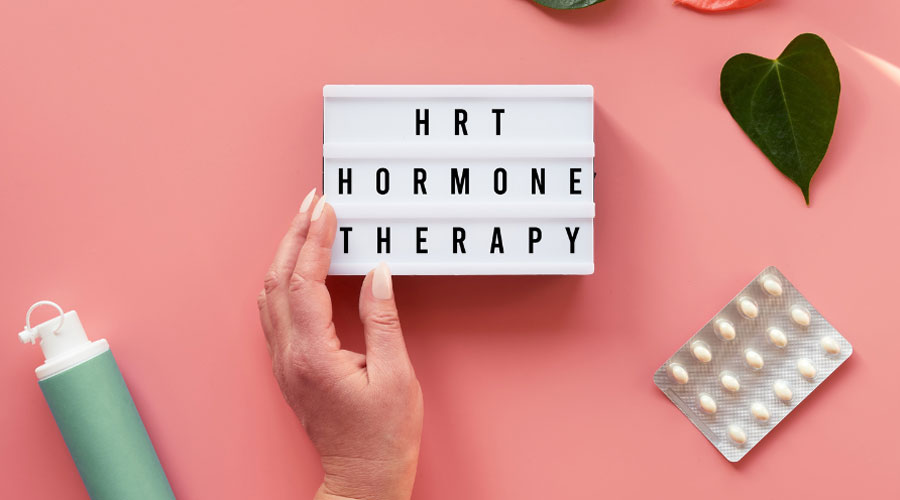HRT: which type is right for you?

As a woman going through the menopause, you have decided that you would like to try hormone replacement therapy (HRT) to relieve unpleasant symptoms.
This is a good start because HRT is very effective in combatting night sweats, hot flushes, mood swings and more, and overall is very safe. The next step is to choose the right type of HRT for you.
HRT comes in different forms, including tablets, gels, patches and pessaries, and many women feel confused by the options available to them. However, choosing the right dose and delivery of HRT will be of huge benefit in helping you deal effectively with your menopausal symptoms.
It is important to consider, with your doctor or other medical professional, your age, medical history and overall health when deciding which type of HRT to try. We are all individuals and just because one type of HRT works for someone else does not mean it is best for you. It may be a case of trial and error, trying different options before making a final choice.
Knowing more about HRT, the different forms and who they are most suited to will help.
What is HRT?
Firstly, it is good to understand what HRT is. HRT replaces the female hormones that a woman’s ovaries no longer produce due to the menopause. It involves supplying two main hormones: estrogen and progestogen (a synthetic version of the hormone progesterone).
Estrogen is a sex hormone that has many roles in the body, including building up womb lining during the menstrual cycle, maintaining bone health and protecting against heart disease. Progesterone is important for egg fertilisation and maintaining a pregnancy.
HRT involves either taking both of these hormones (combined HRT) or just taking estrogen (estrogen-only HRT) and it can be delivered in different ways.
So which form of HRT is right for you?
Choosing how to take HRT may be a matter of personal preference unless there is a health reason why you should take a particular form. It is important to discuss your medical history and the different types of HRT with your doctor.
Here are the main options:
Tablets
One of the easiest and most common ways of taking HRT (either combined or estrogen-only) is in tablet form. You simply need to remember to take your pill once a day.
Try it if…
You want a form of HRT that is simple and easy to take, and you do not have a history of heart disease, stroke or liver problems as the tablet-form can slightly increase your risk of these conditions, although the risk is extremely low.
Skin patches
You stick these patches on your skin and replace them every few days. Both combined and estrogen-only patches are available.
Try it if…
You think you would prefer this method to tablets or gels or you have a history of a clot, diabetes, heart or liver problems as this form of estrogen has fewer risks compared with taking tablets. Patches are easy to use: you peel the backing off the patch and stick it to a hairless area of skin such as your upper arm, hip or upper leg. It delivers a constant absorption of hormones and does not affect the liver or increase your risk of a clot.
Estrogen gel
This is a popular form of HRT which you apply to your skin once a day using a pump-action bottle. Like the patches, the HRT is absorbed into the skin.
Try it if…
You do not want to have to change patches two or three times a week or you think patches might irritate your skin. You may also be able to use the gel if you have a history of heart problems, diabetes and clots as this form of HRT is associated with fewer risks than the tablet form (you should discuss the pros and cons in these situations with your healthcare professional). It is also easy to use.
Estrogen-only HRT
Estrogen in the form of a cream, pessary or ring is placed in your vagina.
Try it if…
You want to relieve vaginal dryness and painful intercourse and do not suffer from other symptoms such as hot flushes which will not be helped by this form of HRT. This type of HRT increases local estrogen levels but does not affect the whole body. This is very safe, with very few associated risks, and can be taken without progestogen even if you still have a womb.
Vaginal estrogen
Try it if…
You no longer have a womb (if you have had a hysterectomy, for example). This is because, although the risk is low, estrogen-only HRT may slightly increase your risk of womb or ovarian cancer if used without progesterone/progestogen.
It can be beneficial to the heart and younger women on estrogen-only HRT have a lower risk of heart disease than women who are not on HRT.
Combined HRT
Try it if…
You still have a womb as the progestogen protects against a very small increased risk of womb cancer associated with taking estrogen-only HRT.
There are two ways of taking it: cyclical combined HRT is best if you have menopausal symptoms and still have periods. This involves having a gap between taking progestogen for a period of time. Continuous combined HRT is recommended if you are post-menopausal and have not had a period for a year. This involves taking estrogen and progestogen every day without a gap and it is thought to decrease the risk of womb cancer.
What about testosterone?

Testosterone is often thought of as a male-only hormone but women produce it too. Many women have low levels of testosterone when they go through the menopause.
Taking testosterone as part of your HRT can help improve your mood, energy levels and libido. Testosterone is usually given as a gel on the skin and at very low doses so it is very unlikely to cause facial hair growth/skin problems.
If you suffer from symptoms such as low libido and increased tiredness, it may be worth consulting your healthcare professional about trying testosterone as part of the HRT you are taking.
Please get in touch if you would like more information about hormonal imbalance and an appointment with one of our healthcare professionals.
Get in touch. We can help.
Would you like to see more blogs from Hormone Health?